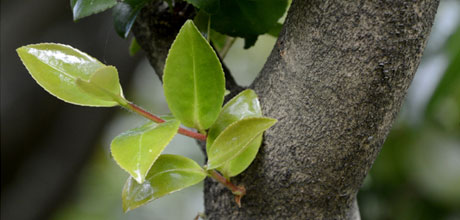Pruning and Adventitious Buds
This article was first published on 03 Dec 2012.

Pruning buds
Dunedin is getting plenty of sun-shine and rain this spring and that is resulting in vigorous growth on the camellias. The young foliage is beautiful and if we look closely and understand the plants response to pruning, we can use their growing power to our advantage.
Camellias are pruned after flowering in spring. The growth produced this season will carry next year’s flowers.
Plants usually grow fastest at their uppermost tips, where hormones stimulate active growth. When these apical or top dominant buds are removed, it encourages lower branches to break into growth. Voila! The result is a bushier plant.
Many plants common in our home gardens - like camellias - have adventitious buds. These dormant buds on the stem, or the root, are often invisible until stimulated into growth. They are a great survival technique. Adventitious buds from stems can help plants replace lost or damaged limbs. Adventitious buds from roots can develop into shoots called suckers which can generate an entirely new plant.
Coppicing involves reducing a shrub or tree close to the ground to encourage multi-stemmed regrowth. As a last resort, this can be a fast solution for a plant which has completely outgrown its space. Camellias can tolerate coppicing and respond with vigorous growth which can need thinning afterwards.
The lower garden camellia collection has finished being pruned this year and yes, there have been some situations where we have taken full advantage of those adventitious buds!
Marianne Groothuis is curator of the camellia and themes collection at the Dunedin Botanic Garden


